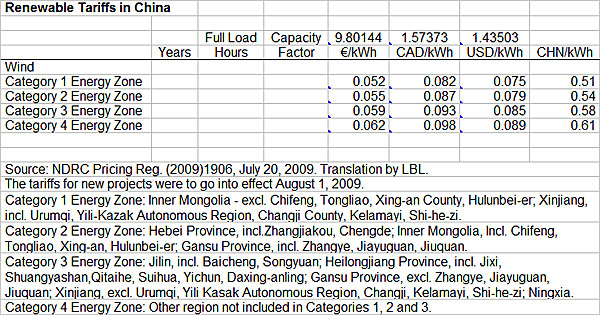China has instituted a new system of differentiated wind energy tariffs based on four wind energy zones. The move is the first in Asia since South Korea implemented a feed-in tariff program in 2005. China now joins a growing list of developing countries with feed-in tariffs, including South Africa and Mongolia.
China is also the first jurisdiction outside Europe to implement wind energy tariffs differentiated by geographic location. Canada’s Ontario province is expected to implement wind tariffs this fall differentiated by two simple classes, those on land, and those offshore. Germany, France, and Switzerland have wind energy tariffs based on wind resource intensity. Currently, no North American jurisdiction has implemented tariffs for wind turbines on land that are differentiated by wind resource intensity or geographic location.
The new program by China’s National Development and Reform Committee [NDRC Pricing Reg. (2009)1906] was issued July 20, 2009. The tariffs for new projects were to go into effect August 1, 2009.
Costs of the new program above the cost of coal-fired generation will be split between provincial grid operators and the central government as in current policy.
The tariffs themselves are less than those in Germany and France and less than those proposed in Ontario. Though the Chinese tariffs are thought to be based on the differences in the wind resource across the vast country, it is impossible to estimate the effectiveness of the tariffs without knowing the specific wind resources of the four wind energy zones. Nevertheless, the Chinese program may represent an innovative hybrid between the graduated wind energy tariffs in Germany and France and those single-value tariffs in Ontario, Vermont, and California.
No further details are available.
The nominal parliament of the Peoples Republic of China passed a Renewable Energy Law on February 28, 2005. The law was widely rumored at the time to include provisions for feed-in tariffs. However, as in most countries, the path to implementation is never direct and only now has specific tariffs been proposed in a program that could be called a system of feed-in tariffs.
Power Engineering is also reporting that China is expected to announce feed-in tariffs for solar PV sometime later this year. The industry trade magazine quoted Suntech chairman Zhengrong Shi as suggesting the tariff for large-scale solar PV plants could be equivalent to $0.22/kWh. Whether these tariffs also include access to state subsidies is unknown.


